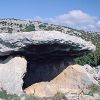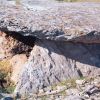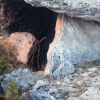Between the abandoned villages of Otín and Nasarre and close to the small village of Rodellar, a path meanders through the Mascun canyon to arrive at the Losa Mora Dolmen.
This is a pre-historic sepulchre constructed by Guara’s first Neolithic shepherds around 4,000 years ago. We know a little of their culture through the testimony of these huge stones, know as megaliths. This one in the Sierra de Guara is part of an important collection than extends from the Pyrenees to the lower mountain peaks. Relating to a new funereal culture that extended across the whole of Europe, dolmens represent a spiritual attitude to death that was different from anything that had been experienced before.
Martin Almargo excavated this dolmen in 1935 and found bones of a number of individuals as well as stone axes, arrow heads and flint knives. From this he deduced that the original builder and his descendents buried their dead in a collective grave in the internal chamber along with their belongings. After the burials, the dolmen was totally covered except for a small opening, forming a huge stone tomb (12 metres in diameter) of which there are still remains. The tomb was made from limestone rocks averaging 20 to 30 cms each, which have been badly eroded. They no longer cover the chamber and only reach a height of 80 cms.
The chamber was located inside the tomb and its internal measurements were 1.80 x 1.90 x 1.20 metres. It was rectangular in shape, slightly trapezoidal, and open to the east. It was almost entirely covered by a single stone slab (2.80 x 2.64 x 0.38m) and had three lateral slabs, one on each side (1.90 x 1.30 x 0.30 m; 1.42 x 1.08 x 0.30m and 2.06 x 1.38 x 0.20 m.) There was also a small slab used as a way to close the tomb (98 x 72 x 14 cm.) All of the slabs are limestone.
These enormous constructions were erected with primitive tools and a lot of effort and required sufficient ingenuity to move the large slabs from the Llastras peak, approximately 500 metres from the dolmen, across rough terrain. What were the reasons for building them? It could have been a belief in the afterlife, a desire to honour their ancestors or the need to create holy or symbolic places. Or maybe they were born of man’s desire to endure through generations. What is certain is that many dolmens have survived until the current day, defying the passage of time.
In the shadow of the dolmen, the shepherds of Guara would tell of legends of witches, lost treasure, fantastic beings and extraordinary happenings such as the one that occurred when a villager from Rodellar went to sell in Nocito. As he passed by the Losa Mora dolmen, a human form with brilliant lights around its head climbed onto the back of his mount and beat the wretched pedlar to a pulp.
Another legend tells of a Moorish king in love with a Christian princess who fled on horseback with his love, pursued by her relations and enveloped by a cloud of arrows. As he dismounted from his horse he discovered that his love has been killed. He wept bitterly, buried her body and built this tomb in her honour. He then went in search of his enemies in order to strike them dead.
It is also told that a spinner wandered through these lands carrying her spinning wheel and a grand rock on her head. Upon arriving at the spot of the dolmen, she left the stone in a horizontal position on top of others wedged there in the ground. The thread that the spinner worked on her wheel represents life; when the thread finished it would signify the moment of her death. So she left the stone that she carried on her head to prepare her own tomb.







